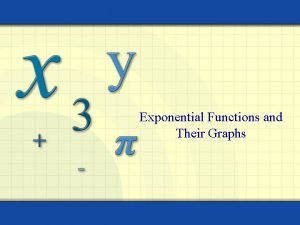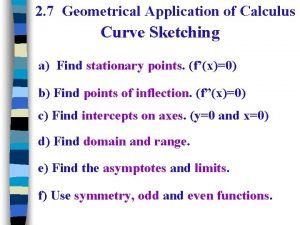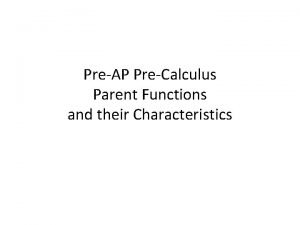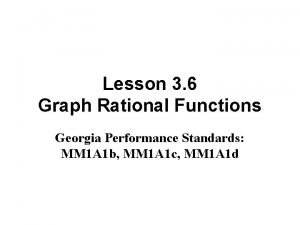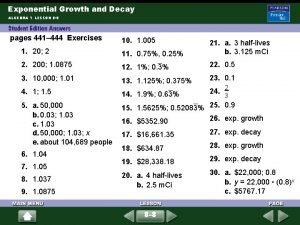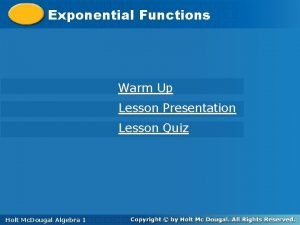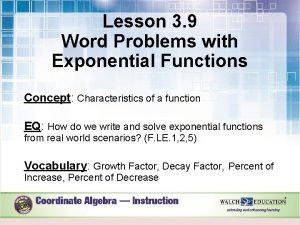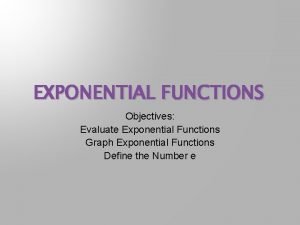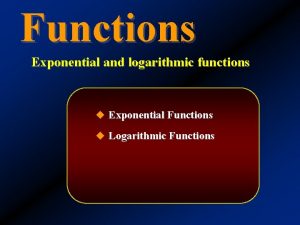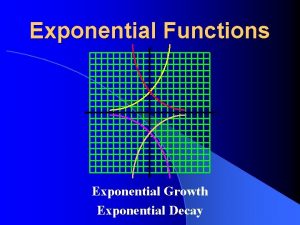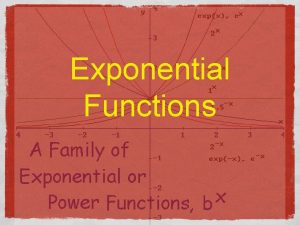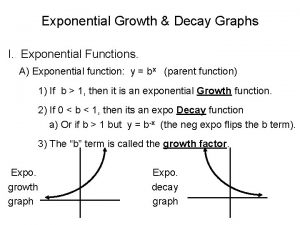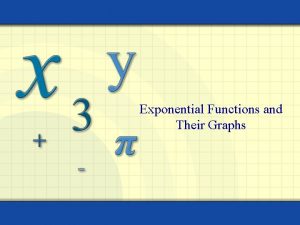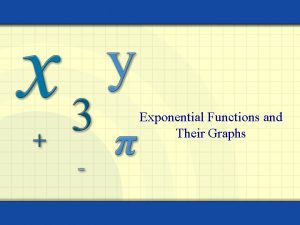Lesson 19 Graphs of Exponential Functions Pre Calculus















- Slides: 15

Lesson 19 – Graphs of Exponential Functions Pre Calculus - Santowski 1/26/2022 Pre. Calculus 1

(A) Review of Exponent Laws n 1/26/2022 Pre. Calculus 2

(B) Exponential Parent Functions n The features of the parent exponential function y = ax (where a > 1) are as follows: 1/26/2022 n Pre. Calculus The features of the parent exponential function y = a-x (where a > 1) are as follows: 3

(B) Exponential Parent Functions n The features of the parent exponential function y = ax (where a > 1) are as follows: n The features of the parent exponential function y = a-x (where a > 1) are as follows: n Domain Range Intercept Increase/decrease on Asymptote As x →-∞, y → As x → ∞, y → n n n 1/26/2022 n n n Pre. Calculus 4

(C) Transforming Exponential Functions n Recall what information is being communicated about the function y = f(x) by the transformational formula 1/26/2022 Pre. Calculus 5

(C) Transforming Exponential Functions – Calculator Explorations n n n Use DESMOS to compare the graphs of: (i) y = 2 x (ii) y = 22 x (iii) y = 23 x (iv) y = 20. 2 x (v) y = 20. 6 x 1/26/2022 n n n Pre. Calculus Use DESMOS to compare the graphs of: (i) y = 4× 2 x (ii) y = -2× 2 x (iii) y = 0. 2× 2 x (iv) y = (⅙)× 2 x (v) y = 10× 2 x 6

(C) Transforming Exponential Functions n n n Graph f(x) = 2 x n Graph g(x) = 4 – 2 x List 3 key points on the parent function n Draw the asymptote and label the intercept(s) n List the transformations applied to f(x) List 3 key points on the parent function Solve g(x) = 0 and evaluate g(0) Draw the asymptote and label the intercept(s) 1/26/2022 n n Pre. Calculus 7

(C) Transforming Exponential Functions n Graph h(x) = 2 x+3 n List the transformations applied to f(x) List 3 key points on the new function Solve h(x) = 0 & evaluate h(0) Draw the asymptote and label the intercept(s) Graph k(x) = 8(2 x) and explain WHY the two graphs are equivalent n n 1/26/2022 n Graph n List the transformations applied to f(x) List 3 key points on the new function Solve m(x) = 0 and evaluate m(0) Draw the asymptote and label the intercept(s) n n n Pre. Calculus 8

(C) Transforming Exponential Functions n n n Graph A(x) = ½x Explain WHY ½x = 2 -x. List the transformations applied to f(x) List 3 key points on the parent function Draw the asymptote and label the intercept(s) 1/26/2022 n Graph B(x) = 2 – 0. 5 x n List the transformations applied to f(x) List 3 key points on the new function Solve B(x) = 0 and evaluate B(0) Draw the asymptote and label the intercept(s) n n n Pre. Calculus 9

(C) Transforming Exponential Functions n Graph C(x) = 23 -x n Graph n List the transformations applied to f(x) List 3 key points on the new function Solve C(x) = 0 and evaluate C(0) Draw the asymptote and label the intercept(s) n List the transformations applied to f(x) List 3 key points on the new function Solve D(x) = 0 and evaluate D(0) Draw the asymptote and label the intercept(s) n n n 1/26/2022 n n n Pre. Calculus 10

(D) Exploring Constraints n Provide mathematical based explanations or workings to decide if f(x) = -2 x is/is not a function n Provide mathematical based explanations or workings to decide if f(x) = (-2)x is/is not a function 1/26/2022 Pre. Calculus 11

(E) Other Exponential Functions n Analyze the end behaviours and intercepts of the functions listed below. Then graph each function on your GDC n (A) Logistic Functions n (B) Catenary Functions 1/26/2022 Pre. Calculus 12

(F) Working with Parameters n You will be divided into groups and each group will investigate the effect of changing the parameters on the characteristics of the function and prepare a sketch of n Where: Group a Z b c d 1 a>1 Z>1 b>1 c>0 d>0 2 a < -1 Z>1 0<b<1 c<0 d>0 3 0<a<1 Z>1 b < -1 c>0 d>0 4 -1 < a < 0 Z>1 -1 < b < 0 c>0 d<0 5 a>1 Z>1 b < -1 c<0 d<0 1/26/2022 Pre. Calculus 13

(G) Exponential Modeling n Investments grow exponentially as well according to the formula A = Po(1 + i)n. If you invest $500 into an investment paying 7% interest compounded annually, what would be the total value of the investment after 5 years? n You invest $5000 in a stock that grows at a rate of 12% per annum compounded quarterly. The value of the stock is given by the equation V = 5000(1 + 0. 12/4)4 x, or V = 5000(1. 03)4 x where x is measured in years. q (a) Find the value of the stock in 6 years. q (b) Find when the stock value is $14, 000 1/26/2022 Pre. Calculus 14 14

Homework n Finish the questions on Slides #8, 9, 10 n From the HOLT Pre. Calculus – A Graphing Approach, Sec 5. 2, p 343 -5, Q 1, 3, 5, 7, 9, 11, 13, 15, 17, 19, 20, 21, 45, 47, 51, 54 1/26/2022 Pre. Calculus 15
 Polynomial end behavior chart
Polynomial end behavior chart Exponential functions and their graphs
Exponential functions and their graphs Sketching graphs calculus
Sketching graphs calculus Parent functions calculus
Parent functions calculus Lesson 3: rational functions and their graphs
Lesson 3: rational functions and their graphs 6-2 inverse functions and relations
6-2 inverse functions and relations Analyzing graphs of functions and relations answers
Analyzing graphs of functions and relations answers Lesson 3 rational functions and their graphs
Lesson 3 rational functions and their graphs Lesson 13-1 exponential growth functions answers
Lesson 13-1 exponential growth functions answers 4-1 exponential functions growth and decay
4-1 exponential functions growth and decay Exponential functions quiz
Exponential functions quiz Lesson 3-1 exponential functions
Lesson 3-1 exponential functions Precalculus honors chapter 1 test
Precalculus honors chapter 1 test Precalculus
Precalculus Pre calculus unit 1 review
Pre calculus unit 1 review Testability tips in state graphs
Testability tips in state graphs

